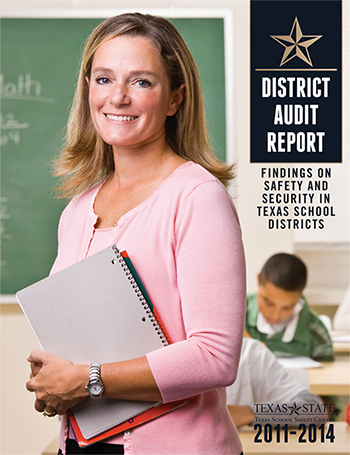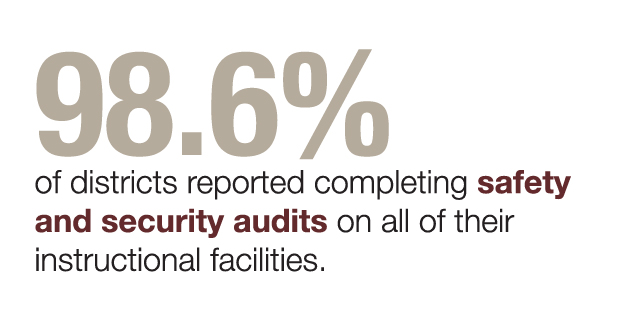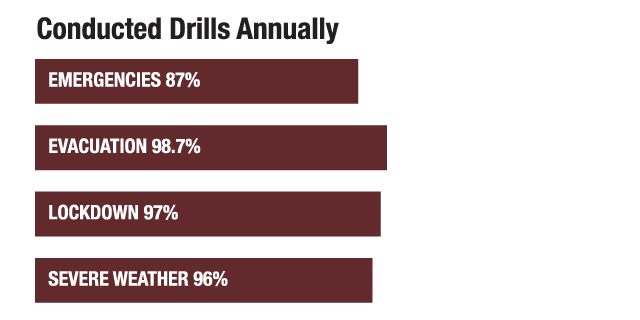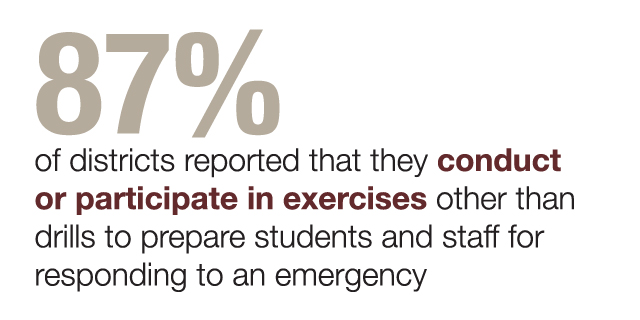TxSSC
2011-2014 DAR Report
Findings on Safety and Security in Texas School Districts

The purpose of the DAR is to provide key results of the safety and security audits completed by Texas public school districts. In accordance with procedures developed by the TxSSC or an equivalent public or private entity, the TEC requires districts to complete safety and security audits of their facilities once every three years (§37.108 (4)(b)). While the term "audit" is included in TEC §37.108 and used throughout this report for consistency, the process was developed as an ongoing self-assessment of a district's safety and security. A summary of the audit results is required to be submitted to the district Board of Trustees as well as the TxSSC, and incorporated into a statewide report for the public (§37.108 (4) (c)) (§37.207(3)).
Further, the TxSSC is mandated to develop safety and security audit procedures and provide each district with guidelines (§37.207 (1)). The audit toolkit for the 2011- 2014 audit cycle included step-by-step instructions and recommendations for conducting audits, as well as a comprehensive audit checklist. The toolkit contains a series of spreadsheets utilizing specific evaluation statements for a variety of facilities and functions. These statements are a combination of best practices, promising practices, and requirements appropriate for a certain type of facility. The audit team should include a cross- functional group of school personnel and collaborative community partners (e.g., local first responders).
Methodology
The DAR provides a summary of safety and security information for the reporting cycle September 1, 2011 through August 31, 2014, which is comprised of self-reported data submitted by school districts in Texas. The TxSSC is authorized by the Texas legislature to determine the method used to collect the audit results, as well as the type of data necessary for collection. Data was collected via the DARtool, an online reporting application developed by the TxSSC, wherein district superintendents or their designees reported specific audit information. Data from the DARtool were analyzed and reported at an aggregate level. Audit results submitted through means other than the online DARtool (e.g., hard copies or email) were not viewed or accepted.
“The purpose of the DAR is to provide key results of the safety and security audits completed by Texas public school districts.”
The TxSSC did not substantiate the data reported by districts and the accuracy of responses received from each district was presumed. Additionally, the TxSSC also took measures to safeguard the confidentiality of each reporting district by structuring the questions to protect against identification. According to TEC 37.108 (c-1), safety and security audit information is not subject to disclosure. However, certain exceptions regarding disclosure are permitted under TEC 37.108 (c-2).
The TxSSC attempted to collect audit information from 1,027 public school districts including Independent School Districts (ISDs), Common School Districts (CSDs), the Texas School for the Deaf, and the Texas School for the Blind and Visually Impaired. Since charter schools do not fall under the TEC Chapter 37 reporting requirements, they were not included in the reporting process.

A total of 1,027 districts reported audit results via the DARtool. In contrast to the 96.3% response rate from the previous audit cycle (2008-11), the TxSSC received audit report information from 100% of the districts for the 2011-14 audit cycle.
Major Findings
- The majority of districts (98.6%) reported completing safety and security audits on all of their instructional facilities and to a lesser extent on non-instructional facilities (94.4%).
- Over half of the districts (59.4%) used a District Audit Team to conduct their audits.
- A large majority of districts (89.5%) reported having a functioning School Safety and Security Committee that meets regularly.
- The majority of districts (97.2%) reported having a Multi-Hazard Emergency Operations Plan (EOP). In addition, the majority of these districts (97.8%) indicated the Multi-Hazard EOP addressed all four phases of emergency management (i.e., mitigation/prevention, preparedness, response, and recovery) and is reviewed annually and updated as needed (97.0%).
- Evacuation drills were the most frequently conducted (98.7%) by districts annually for each instructional facility, while 97%, 96%, and 92% of districts reported conducting lockdown, weather, and shelter-in-place drills annually for each instructional facility, respectively. To a lesser extent, districts reported they conducted reverse evacuation drills (87%) annually for each instructional facility.
- Over 58% of districts reported that all drills were conducted annually for each non-instructional facility. Specifically, 66.9% of districts reported that they conducted evacuation drills annually for each non-instructional facility, while 65.3%, 64.8%, and 61.7% of districts reported conducting weather, lockdown, and shelter-in-place drills annually for each non-instructional facility, respectively. To a lesser extent, districts reported they conducted reverse evacuation drills (58.7%) annually for each non-instructional facility.
- Over 87% of districts reported that they conduct or participate in exercises (other than drills) in an effort to prepare staff and students for responding to an emergency.
- Approximately 97% of districts indicated they had identified key personnel responsible for specific emergency functions.
- A majority (57.0%) of districts reported that school and safety security improved to a great extent, followed by districts who reported their safety and security improved somewhat (40%). Only three districts reported that their safety and security did not improve at all since the last audit cycle.

Recommendations
Texas school districts continue to work diligently toward keeping our children safe and secure. This is evident in the 2011-14 DAR, which suggests the majority of Texas public school districts are implementing safety and security measures required under Chapter 37.108 of the Texas Education Code. The following recommendations are proposed to further assist schools in maintaining and strengthening their safety and security programs.
- School Districts Should Engage in Collaborative Preparedness Efforts - The safety and security audit process was designed for cross-functional groups of school personnel from various disciplines (e.g., transportation, food services, health, and maintenance) and community partners (e.g., first responders and emergency management personnel).
- School Districts Should Audit and Develop Emergency Plans for Non-Instructional Facilities - Audits should include all noninstructional facilities. Emergency incidents can impact non-instructional facilities within the school district and, may interfere with the business of teaching and learning as well as result in the loss of life and property. The criticality of developing an emergency plan for non-instructional facilities must be addressed in order for school districts to achieve a comprehensive safety and security program.
- School Districts Should Conduct Drills at Both Instructional and Non-Instructional Facilities - The audit process ensures districts are actively participating in drills at all facilities (i.e., instructional and non-instructional). Texas school districts should conduct drills such as lockdown, evacuation, reverse evacuation, shelter-in-place, and severe weather drills in order to demonstrate the protective actions to be taken during an incident.
- School Districts Should Address Recovery in District Multi-Hazard Emergency Operations Planning - Recovery activities should involve procedures for the resumption of classes and education support services, financial recovery, physical recovery for damaged or impacted buildings, recovery of data or Information Technology Systems, and emotional or psychological recovery of students, staff, and community.
